


 |
El Charco del Ingenio (Botanical Garden) |
 |
La Parroquia (Cathedral San Miguel Allende) |
 |
Return to the Index for Our Mexico Trip |
While there are other parks and squares in San Miguel, and while one of the other squares in the historic district is considered to be the "old" Spanish town square, the Jardin Allende, situated as it is between the family homes of two of the town's most significant individuals and right in front of the spirtual home of the city (La Parroquia), Jardin Allende is the city's heart- its main gathering place.
|
Like many Mexican town centers, San Miguel's Jardin achieved its pseudo French-garden character around the turn of the 20th century when a rising wealthy Mexican elite began to mimic European ways, especially those of the French. Starting in the 1870s, Mexico was ruled for parts of 5 decades by José de la Cruz Porfirio Díaz Mori. The Mestizo Diaz loved French stuff despite the Maximilian Affair which made him a household name. Diaz's long tenure gave him time to share his Francophile public designs with many Mexican town centers. He also developed an ingenious method of getting reelected president: he habitually had his opponents assassinated if there was any chance that they might beat him. Somehow viable candidates became few and far between. He died in exile (in Paris, of course).
Any time of the day or night, it seems the Jardin is home to expats, tourists, and locals alike. The carefully maintained Mexican laurel trees provide needed shade on warmer days. For many of the locals, their small houses do not provide much space for visitors, so the Jardin serves as their living room. (It may also serve as their den now that it has free WiFi.) For me, the fact that a Starbucks has opened across the street from the northwest corner of the square, detracts somewhat from the old Spanish Colonial vibe that I think the Jardin once had.
I want to take you on a tour around the Jardin; each side of the "garden" is different, and each has something to see. Let's begin with the area we visited most frequently.
The Plaza (South Side)
San Miguel has a bigger square in the central historic district, but not as green, and bigger green spaces, but not as well trafficked as this lovely space that most consider the heart of the town (with the soul across the street at La Parroquia).
|
In the picture at left, I am standing at the top of some steps that lead up from Correo Street (the street that exits the Jardin Area at its southeast corner) to the Iglesia de San Rafael, and so this view looks basically west. La Parroquia is at the left, and the building behind my head was the home of the Allende family and of Ignacio Allende. Across Umaran Street (which exits the Jardin to the west at its southwest corner) are some restaurants and stores extending down the west side of the Jardin Allende, some of which you can see at right.
Our usual route to the plaza from Casa Pina brought us up Cuna de Allende, a narrow street between La Parroquia and the buildings behind my head. This particular picture was taken at noontime on a weekday, and still there are many people in and around the Jardin.
|
Taken late in the day, this picture looks towards the southeast portal to Jardin Allende:
 |
On reviewing all the movies we took here in the south plaza of Jardin Allende, we came to realize that in almost every one, it is tough to avoid the obligatory pan up and down the front facade of La Parroquia, and we did that frequently. Of all the many movies that we made here in the plaza south of Jardin Allende, these two are representative:
|
This movie was made from a point just at the bottom of the church steps and it pans across the plaza and Jardin looking north. |
This movie is kind of the opposite, taken from a point near the Jardin and panning across the plaza mostly looking to the south. |
The Southwest Corner of Jardin Allende
To look at all our good pictures of the Jardin Allende area, let's work our way clockwise around the Jardin, and first move from the south plaza to the southwest corner of the plaza. At that corner, the short street Cuna de Allende comes up to the Jardin from the south; this is the street that we walk up and down when we are coming here from Casa Pina. Another street, Umaran, heads west from the square. In the picture below, we are looking directly south down Cuna de Allende, with La Parroquia on the left. (That's Greg and I on the corner.)
|
Allende, whose name became part of the town's, was born in 1769 to a wealthy Spanish criollo family in San Miguel el Grande (the town's former name). His father was Domingo Narciso de Allende, a wealthy trader. In 1802, Ignacio joined the army, serving under general Félix María Calleja.
In 1806, he started to favor the possibility of independence from Spain. His 1809 attendance at a conspiratorial meeting in a nearby town was discovered by the Spanish but went unsanctioned. Regardless, Allende kept supporting the underground independence movement. He was eventually invited by a local mayor to discuss further plans for independence, and during one of those meetings where Allende met Miguel Hidalgo y Costilla and his captain Juan Aldama (for whom the street Casa Pina is on was named).
Originally, the independence movement was to be led jointly by Allende and Aldama. A change of plans prompted by the discovery of the conspiracy forced Hidalgo to start the rebellion earlier than agreed. The "Grito de Dolores" uttered by Hidalgo signaled the beginning of the revolution, after which the conspirators rallied behind him.
|
Allende was taken to the city of Chihuahua where he was tried for insubordination and imprisoned. While he believed in and supported Independence from Spain, he was loyal to Mexico, and when he learned that a few thousand Americans were massing near present-day San Antonio, he asked for a meeting with the viceroy in order to contemplate a joint solution in defending against a potential American invasion. His request was denied and he was executed by firing squad on June 26, 1811. His body was decapitated and his head taken to the Alhóndiga de Granaditas where it was shown to the public inside a cage hung from one corner of the building. In 1824 his remains were buried in the vault reserved for the viceroys and presidents in the cathedral of Mexico. His remains were moved in 1925 to the Independence Column in Mexico City.
The 17th century neoclassical Allende home has many baroque embellishments laid out in perfect symmetry, but in the rest of the facade (most of it facing Umaran Street) no two windows are alike. There are no religious statues here, but a white statue of Allende watching the scene from his second-story perch. Many locals point out that the statue seems to be keeping a stone eye on the home of San Miguel's other most-prominent family- the Canals- whose mansion is at the end of the block that forms the west side of Jardin Allende. Canal was the commander of the local Spanish garrison, but he kept his troops away when the Revolutionary Army was formed on September 22, and a revolutionary mob ransacked the city on that night in 1810.
No one who visits this house should view its most famous occupant, Ignacio Allende, as a poor revolutionary. Allende was very wealthy, and his reason for supporting independence from Spain was to enhance and solidify the position of the Mexican aristocracy- not necessarily the lower classes. As a matter of fact, on the night the mobs were running through the city, supporting a rebellion against the rich, Spanish or no, Allende rounded up all his aristocrat Spanish neighbors and locked them inside a nearby college building to keep them safe.
Here are two more pictures taken here at the southwest corner of the square, both looking down Portal Allende. That's the mansion of the Canal family (now a Citibank building) at the end of the block:
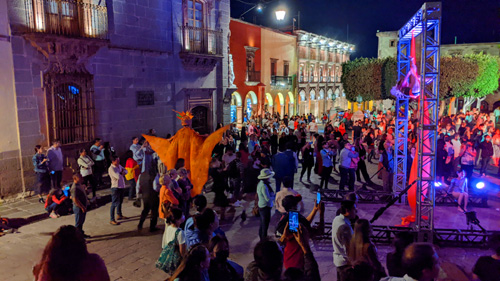 |
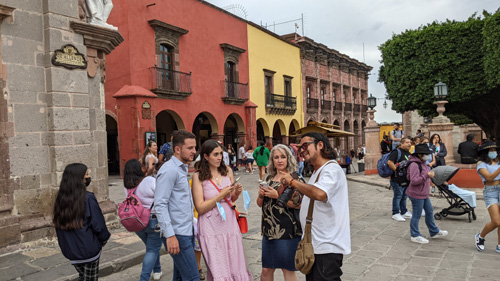 |
A Fixture for the Tourists
While we are here at the southwest corner, I should mention what seemed to be a daily fixture here at the corner. Almost all the time, one could find the two tourist bureau employees in their outsized costumes, standing around for anyone to use as a photo backdrop.
|
But when the figure were here, they did a pretty constant "business", letting people photograph each other with them. (Although in one of the pictures, we learn that this gig is perhaps not all it's cracked up to be.)
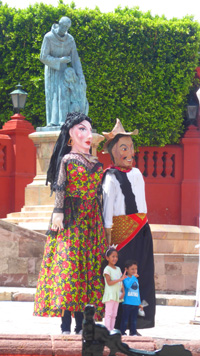 |
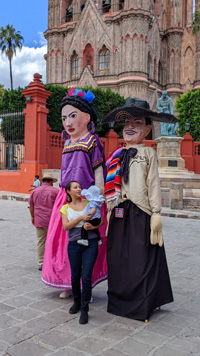 |
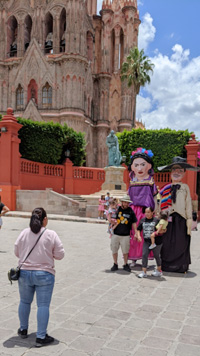 |
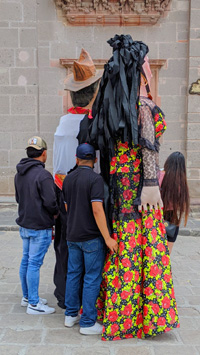 |
On the various days we saw the figures here, we only saw the two different sets. Whether this means there are only two actual humans to perform this task, I have no way of knowing. Nor do I know if there are more costumes used.
The West Side of Jardin Allende
Of the four walkways that surround the Jardin (all of which are closed to vehicles, of course), the narrowest of them is the one on the west side. Because the walkway was fairly narrow, and because there is not a lot to photograph on this side of the square, we didn't take many photographs here, and the ones we did take weren't all that meaningful.
|
It shows what is very typical of buildings of their era; there would be families living upstairs, and the bottom floor would be given over to commercial space. This model is typical of most cities around the world, and the older they are the more common it is.
Here, the families living in the yellow and orange spaces would have been quite well-to-do, and we know exactly who lived in the larger space at the far end. This was the home of the Canal family. De la Canal was the commander of the local garrison, and he kept his troops away while his neighbor Allende's mob ransacked the city on that fateful night in 1810.
The commercial space below the Canal mansion, and indeed the mansion itself, is now the Banamex building; the banking conglomerate was gobbled up by CitiGroup in 2001. They occasionally exhibit their art collection inside. This was actually the family's winter residence; their summer estate was, oddly enough, only a mile away and is now the Allende Institute, an internationally acclaimed art school. You'll see that residence shortly. The street that runs along the north side of the Jardin is named for the Canal family.
South of the bank building, the ground floor houses a small grocery/convenience store and a restaurant at the south end. We ate dinner at that restaurant with Darrell and Lisa one evening. The restaurant has outdoor seating under the arcade, and it is a popular place during the day. The diners seem to attract the various Mariachi musical groups wander regularly through the square, "playing for pay".
|
|
|
Canal Street: The North Side of Jardin Allende
The North side of the Jardin Allende was its least-busy area. The buildings that border the north side of the park are almost all still residences or offices, and there is relatively little public space (stores and such) on the ground floor in this block.
|
The buildings on the north side of the Jardin are the newest of the three sides of the square (not counting the Parroquia). Down at the corner in the row of buildings at the right, is the Posada (hotel) San Francisco. The corner was at one time the residence of a Canal relative, but in 1939 the building was almost totally rebuilt to serve as a hotel. Sadly, they didn't have the money to make the outside of the structure as ornate as the actual Canal mansion, but they did their best. The hotel was the first hotel in town built specifically for tourists; its target were the art students who came to San Miguel. Since they had small budgets as well, they were a good match for the hotel.
The one store the I patronized in the row of north-side buildings was at the extreme east end- an ice cream parlor.
On the East Side of Jardin Allende
The east side of the Jardin was by far the busiest. I am not counting the south side plaza of course, as the Parroquia and the various events that are put on in that large plaza draw a great many people.
|
|
The buildings along the east side of the square have, on their ground floors, numerous restaurants and stores, and its probably because there is so much foot traffic here that this is the case. This side of the square was spacious enough that there were occasionally mobile food stands set up here, serving a variety of items- including ice cream. You can also see that the Jardin itself had entrances at each corner. On the north side, there were stairs up to the park, but the park was at grade with the southside plaza.
|
|
Back at the Southeast Corner of the Square
Well, we began on the south side of the square and have walked clockwise around it to find ourselves back at the southeast corner. Here, I made an interesting panoramic picture that is 90° wide; straight ahead you are looking due west, and at right you are looking due north.
 |
In the Jardin Allende
Well, we've walked all the way around the actual Jardin Allende, so let's now go into it to see what it's like. We might as well just go through the entrance ahead of us here at the southeast corner.
|
|
Anyway, while San Miguel has a bigger square in the central historic district (but not as green as the Jardin), and bigger green spaces (but not as well-trafficked as the Jardin), the Jardin Allende is what most consider the "heart" of the town (with the "soul" across the street at La Parroquia).
|
First, there is a continuous walkway that goes around all four sides of the Jardin, and on all four sides there is a row of wrought-iron seats that face out in all four directions. On the north and south sides, there are actually two rows of these seats, as you can see here. This "outer" row is not present on the east or west sides as there is not so much room on those sides.
The garden itself has diagonal walkways that go corner to corner, as well as walkways that go north-south and east-west. All of these walkways are lined with more seats, and on nice days these are almost always full- particularly when they face out onto one side of the square or the other.
|
|
In the very center of the Jardin there is a gazebo, although I never saw it used for anything official. There aren't any benches on it:
|
|
Below is an interesting picture I took here in Jardin Allende. Before I tell you what it is, you might want to take a minute to see if you can figure out what it shows and how I took it:
 |
It looks as if I am on the balcony of a long building, but I'm really not. I went up onto the gazebo and then took a picture looking in each of the four compass directions. Then I used my software to stitch the four pictures together. If you look at the gazebo, you'll see there are four ways up into it, and those are the four "gaps" in what would otherwise be a continuous fence-like railing.
One thing you'll see frequently is a mariachi band seranading its paying customers:
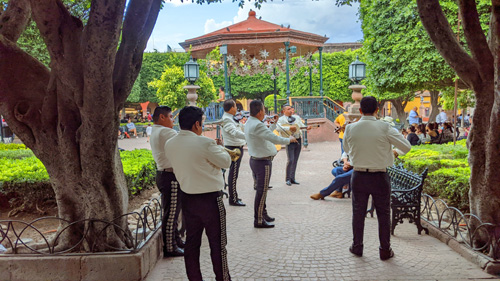 |
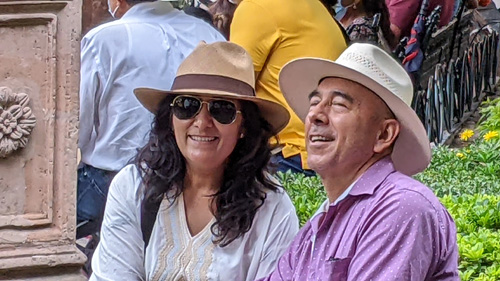 |
Speaking of these wandering minstrels, they were ubiquitous in the square, and so there was almost always some music in the background when we walked around the Jardin. It was hard to resist making movies of them:
|
|
movietext |
On weekends, there were even groups playing at night:
|
|
As I said, you could see just about everything- a local with his pet and an expat artist creating probably the millionth drawing of La Parroquia:
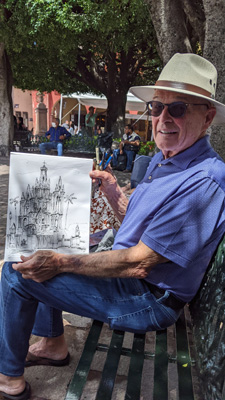 |
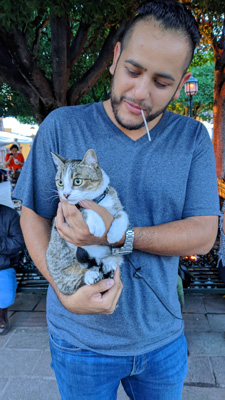 |
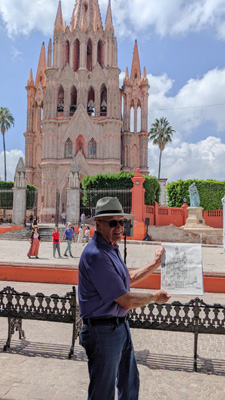 |
We came here frequently to relax, which seemed to be a common pastime in Jardin Allende:
 |
 |
Jardin Allende: San Miguel's Living Room- and Stage
During our visit, we found that the Jardin Allende- particularly the plaza between it and La Parroquia- was fairly often turned into a stage for events- mostly at night but sometimes during the day as well. It's a great space for this sort of thing- kind of like Red Rocks but instead of red rocks there's either a garden or an ornate church overlooking the festivities. And La Parroquia was particularly beautiful when lit up at night.
The biggest gathering was on August 12th, and that was when we took most of our pictures and movies of events in the plaza between the Jardin and the Parroquia. First, here are a couple of movies of the preparations for the evening event:
|
In this movie, I am close to and at the side of the stage so you can see clearly what the woman is doing. She is playing what is, in effect, a gigantic harp. The strings of the harp are anchored on the stage and on the Parroquia! |
It is really only when you view the performers from the side that you can see the strings that stretch up from the stage, but even in the daytime it is hard to see just where on the church facade they are anchored. |
As you can hear, plucking the strings does sound like a harp. Of course, the strings have frets on them at verious heights, with the most of them being perhaps ten feet up the strings from the "harpist". If there were no frets on the strings, they would make little sound at all, being as long as they are. Even when pulled on with great strength, what sound they would make would be uniformly very, very low- almost too low to hear.
|
 |
I honestly don't know whether the performance was the celebration of some special day or to mark some special occasion, but I do know that being a part of the evening event was very enjoyable.
Both Fred and I took pictures and movies, and here are just a few of them:
|
|
|
And here are some still shots of the crowd:
 |
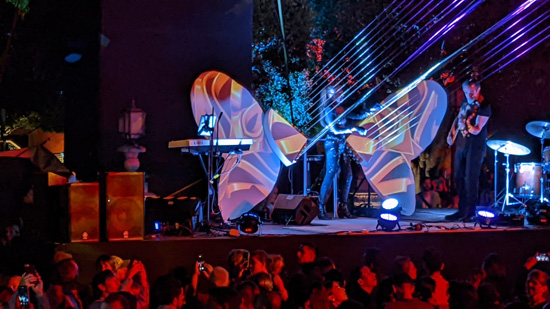 |
That was not the only nighttime event; there were a couple of others, but they seemed to be staged similarly, with colored floodlights illuminating the crowd.
The Jardin was also the scene of numerous events during the day, including an arts and crafts fair (more on that a bit later) and a parade of the same kind of oversized figures that one could usually find in the square's southwest corner. I am not sure, again, whether this was some particular holiday or celebration, but watching all the figures parade entirely around the square was one of the most interesting times we spent in the Jardin Allende.
|
|
|
There is one more event that I want to show you. Although it took place in the Jardin Allende, we did not go there to watch it. In fact, that it was held at all was a surprise to us, although it might have been announced in the square in Spanish.
|
|
I suppose that had we known this event would occur, we might have considered staying in the plaza to watch, but I doubt we would have had a good view; we would have been too close to the action.
But we didn't know, and it wasn't until we had been back at Casa Pina for an hour or so that we heard the booming beginning. In our courtyard, we couldn't quite tell what was happening, but then we happened to see the reflection of the fireworks in the upstairs windows of the bedroom above ours.
So we headed up to the rooftop patio on top of that building and found we had the very best of views of the display. We each made movies, but they were so similar that I'll only include one of them here. Use the movie player at left to watch about five minutes worth of the show.
The Jardin Allende was definitely the center of the action here in San Miguel. We spent a lot of time there; it was a place to see and be seen for just about everyone, and there was always something interesting or photogenic to focus on.
You can use the links below to continue to another photo album page.
 |
El Charco del Ingenio (Botanical Garden) |
 |
La Parroquia (Cathedral San Miguel Allende) |
 |
Return to the Index for Our Mexico Trip |